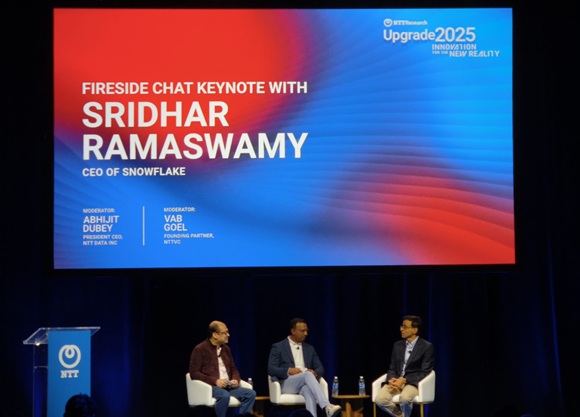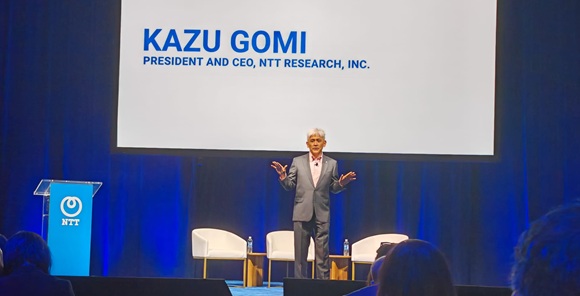NTT hosted its Upgrade 2025 event this month in San Francisco. Known as Upgrade because the company wants us to think about the technologies and processes that will “upgrade reality”, the company used the event to detail both hardware and software-centric development.
President and CEO of NTT Research Inc. Kazu Gomi kicked off the keynote for this event and explained how the event works to showcase innovations from the company’s R&D division in Japan, USA and elsewhere around the world across the organisation’s global offices.
The demos on show this year are once again spread across early stage development, those in more advanced stages of incubation and those ready for service deployment.
With 2300 researchers around the world and 18,000 patents, NTT’s R&D division continues to grow.
“We have morphed our business model and R&D focus through eras of telecoms, to the Internet… to cloud to IT total solutions and now into AI through the years, we are proud to say that this process has adapted (and in many areas led) R&D development for these tiers of technology through the years,” said Gomi.
Quantum cryptography
The company’s R&D interests are spread over three labs spanning quantum cryptography, advantage cryptography and bio digital twin work, the latter being focused on medical and health informatics.
This year, NTT Corporation announced a new, large-scale integration (LSI) chip for real-time AI inference processing of ultra-high-definition video up to 4K resolution and 30 frames per second (fps). This low-power technology is designed for edge and power-constrained terminal deployments in which conventional AI inferencing requires the compression of ultra-high-definition video for real-time processing.
Gomi san also covered the fact that NTT Research has unveiled the Physics of Artificial Intelligence Group, spun off from a group within the NTT Research Physics & Informatics (PHI) Lab.
The Physics of AI
The new group will continue to advance the “Physics of Artificial Intelligence,” an interdisciplinary approach to understanding AI pioneered by the team over the past five years. NTT Research Scientist Dr. Hidenori Tanaka, an expert in physics, neuroscience, and machine learning who led the PHI Lab’s Intelligence Systems Group, will become head of the Physics of Artificial Intelligence Group.
The group will be working to understand where AI is doing the wrong things (in terms of bias and hallucinations etc.) and apply what it calls “medicine” to bad neural connections.
Speaking on stage at NTT Upgrade, Dr. Tanaka asserted that there is no question as to whether AI will end up being more intelligent than humans, it will. He referred to how robotics and AI has developed so far in his home country of Japan and talked about how (just like any human relationship) our relationship with AI technology is all about understanding.
“Any type of harmony – in this case between humans and AI – is all about understanding. So with that motivation, the company has been working to deconstructing the physics (and indeed the neuroscience of AI) for many years now,” said Tanaka “You should know that ”AI can be a ‘dream box’ (and not just a black box) for the science of intelligence if we really start to understand how the neurons inside any given AI model actually work.”
He thinks that the way AI has developed now, we can say that the study of intelligence is the new frontier of physics itself.
“The key for AI to exist harmoniously alongside humanity lies in its trustworthiness and how we approach the design and implementation of AI solutions,” said Tanaka. “With the emergence of this group, we have a path forward to understanding the computational mechanisms of the brain and how it relates to deep learning models. Looking ahead, our research hopes to bring about more natural intelligent algorithms and hardware through our understanding of physics, neuroscience and machine learning.”
Because the “personalities” of AI models and engines today are built the way they are (with ChatGPT being a good example) the interactions that AI is capable of are optimised for one-on-one interactions (or we should say one human to one AI), there may be scope for wider connection channels in the future.
NTT defines ‘Identity of IOWN’
As part of this show, attendees also learned that NTT Corporation has come forward with a new English-language book which explores the capabilities of advanced optical-photonic and wireless networks. The newly translated book explores NTT’s vision of IOWN and how it will enable a more sustainable society in an increasingly data-driven world.
The Identity of IOWN is a book outlining the company’s development and implementation of a global optical and advanced wireless network to enable more efficient and environmentally sustainable computing technologies.
The Innovative Optical and Wireless Network (IOWN) Initiative aims to enable a smarter world by moving beyond electronics into a photonics-based future that responsibly realises the enormous potential of advanced technologies like artificial intelligence, robotics and the Internet of Things (IoT) across a variety of industries, from finance and healthcare to sports and live entertainment.
The book highlights the four stages of IOWN’s planned commercialisation and deployment.
All-Photonics Network (APN)
Following the initiative’s announcement in 2019, NTT contributed to the completion of the first stage (known as IOWN 1.0) with the initial commercialisation of its All-Photonics Network (APN) in March 2023.
The APN seeks to maximise the efficiency and performance of long-distance data transfer by eliminating optical-electronic-optical conversions along the transmission path. In 2024, NTT launched IOWN 2.0 to expand the initiative from networks to computing, announcing the development of photonics-electronics convergence (PEC) devices to advance light-based connections between computer boards. NTT is targeting the commercialisation of these devices in 2026.
“The price of humanity’s rapid industrial development has been the heavy burden placed upon the Earth,” notes NTT president and CEO Akira Shimada. “Climate change has begun exerting a serious impact around the world. While the Internet has transformed our lives through digitalisation and otherwise, it also poses major challenges and opportunities. There is a way to simultaneously achieve solutions for both issues – the challenges and opportunities posed by the internet and the need to manage power usage to ensure global sustainability – and thereby create a better society – through the IOWN Initiative.”
Around 2029, IOWN 3.0 will further miniaturise these devices to the millimeter scale for light-based connections between semiconductor chips.
Towards 2032 & IOWN 3.0
Beginning around 2032, IOWN 4.0 will see the further development of PEC devices enabling optical signaling inside chips themselves, thus entering the micro realm of optical semiconductors.
Ultimately, these four stages aim to culminate in enabling IOWN’s three key performance targets: a 100x increase in power efficiency, a 125x increase in transmission capacity and a reduction in latency by 200x as compared to contemporary infrastructure.
“Building the future of computing requires global collaboration and partnership,” said Sean Lawrence, vice president, head of IOWN Development Office, NTT. “NTT was able to foresee the data transmission and processing demands of the future, conceptualising IOWN after decades of fundamental research and development in optics and computing. The need for IOWN is further exacerbated by AI, and we look to IOWN to unlock AI’s full potential in a far more sustainable way.”
IOWN is supported by the IOWN Global Forum, a non-profit organisation established in 2020 by founding members NTT, Intel and the Sony Group to promote the international development and adoption of IOWN technologies. Today, the IOWN Global Forum has grown to include more than 150 member companies and organisations, such as Cisco, Google, Microsoft and capitalisation-focused company Nvidia.
In the book’s afterword, senior executive vice president and CTO at NTT Katsuhiko Kawazoe describes IOWN as “unlimited innovation,” referring to the ability of IOWN to allow us to “paint a picture of a new future” by leaping past the limits of our thinking that is premised on the technologies at our disposal now.




Image credit: Eliane Fiolet, co-founder & eitor – Ubergizmo
